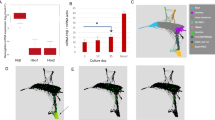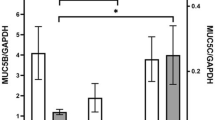Abstract
Nitric oxide (NO) is present in air derived from the nasal airways. However, the precise origin and physiological role of airway-derived NO are unknown. We report that NO in humans is produced by epithelial cells in the paranasal sinuses and is present in sinus air in very high concentrations, close to the highest permissible atmospheric pollution levels. In immunohistochemical and mRNA in situ hybridization studies we show that an NO synthase most closely resembling the inducible isoform is constitutively expressed apically in sinus epithelium. In contrast, only weak NO synthase activity was found in the epithelium of the nasal cavity. Our findings, together with the well-known bacteriostatic effects of NO, suggest a role for NO in the maintenance of sterility in the human paranasal sinuses.
This is a preview of subscription content, access via your institution
Access options
Subscribe to this journal
Receive 12 print issues and online access
$209.00 per year
only $17.42 per issue
Buy this article
- Purchase on Springer Link
- Instant access to full article PDF
Prices may be subject to local taxes which are calculated during checkout
Similar content being viewed by others
References
Stein, J.H. Internal Medicine (Mosby-Year Book, Inc., St Louis, Missouri, 1994).
Knops, J.L., McCaffrey, T.V. & Kern, E.B. Inflammatory diseases of the sinuses. Otolar. Clin. N. Am. 26, 509–534 (1993).
Björkwall, T. Bacteriological examinations in maxillary sinusitis (University of Helsinki, 1950).
Marsden, P.A. et al. Structure and chromosomal localisation of the human constitutive endothelial nitric oxide synthase. J. Biol. Chem. 268, 17478–17488 (1993).
Geller, D.A. et al. Molecular cloning and expression of inducible nitric oxide synthase from hepatocytes. Proc. natn. Acad. Sci. U.S.A. 90, 3491–3495 (1993).
Nathan, C. & Xie, Q.-W. Nitric oxide synthases: Roles, tolls, and controls. Cell 78, 915–918 (1994).
Nathan, C. Nitric oxide as a secretory product of mammalian cells. FASEB J. 6, 3051–3064 (1992).
Croen, K.D. Evidence for an antiviral effect of nitric oxide. J. Clin. Invest. 91, 2446–2452 (1993).
Alving, K., Weitzberg, E. & Lundberg, J.M. Increased amounts of nitric oxide in exhaled air of asthmatics. Eur. Resp. J. 6, 1368–1370 (1993).
Lundberg, J.O.N. et al. Primarily nasal origin of exhaled nitric oxide and absence in Kartagener's syndrome. Eur. Resp. J. 7, 1501–1504 (1994).
Afzelius, B.A. A human syndrome caused by immotile cilia. Science 193, 317–319 (1976).
Dagerlind, Å., Friberg, K., Bean, A.J. & Hökfelt, T. Sensitive mRNA detection using unfixed tissue: combined radioactive and non-radioactive in situ hybridization histochemistry. Histochemistry 98, 39–49 (1992).
Morb. Mortal. Wkty. Rep. 37, S-7 (21) (1988).
Hamid, Q. et al. Induction of nitric oxide synthase in asthma. Lancet 342, 1510–1513 (1993).
Asano, K. et al. Constitutive and inducible nitric oxide synthase gene expression regulation and activity in human lung epithelial cells. Proc. natn. Acad. Sci. U.S.A. 91, 10089–10093 (1994).
Shechtman, F.G., Kraus, W.M. & Shaefer, S.D. Inflammatory Diseases of the Sinuses. Otolar. Clin. N. Am. 26, 509–516 (1993).
Mancinelli, R.L. & McKay, C.P. Effects of nitric oxide and nitrogen dioxide on bacterial growth. Applied Environ. Microbiol. 46, 198–202 (1983).
Puybasset, L. et al. Inhaled NO in ARDS: Dose-response curves. Br. J. Anaesthesiol. 72 Suppl 1, 56 (A 107) (1994).
Jain, B., Rubenstein, I., Robbins, R.A., Leishe, K.L. & Sisson, J.H. Modulation of airway epithelial cell ciliary beat frequency by nitric oxide. Biochem. Biophys. res. Comm. 191, 83–88 (1993).
Lundberg, J.O.N., Hellström, P.M., Lundberg, J.M. & Alving, K. Greatly increased luminal nitric oxide in ulcerative colitis. Lancet 344, 1673–74 (1994).
Middleton, S.J., Shorthouse, M. & Hunter, J.O. Increased nitric oxide synthesis in ulcerative colitis. Lancet 341, 465–466 (1993).
Lundberg, J.O.N., Weitzberg, E., Lundberg, J.M. & Alving, K. Intragastric nitric oxide production in humans: Measurements in expelled air. Gut 35, 1543–1546 (1994).
Rachmilewitz, D. et al. Peroxynitrite-induced rat colitis: A new model of colonic inflammation. Gastroentemlogy 105, 1681–1688 (1993)
Author information
Authors and Affiliations
Rights and permissions
About this article
Cite this article
Lundberg, J., Farkas-Szallasi, T., Weitzberg, E. et al. High nitric oxide production in human paranasal sinuses. Nat Med 1, 370–373 (1995). https://doi.org/10.1038/nm0495-370
Received:
Accepted:
Issue Date:
DOI: https://doi.org/10.1038/nm0495-370
This article is cited by
-
Elevated nitric oxide and carbon monoxide concentration in nasal-paranasal sinus air as a diagnostic tool of migraine: a case – control study
BMC Neurology (2021)
-
Nitric oxide unravels the enigmatic function of the paranasal sinuses: a review of literature
The Egyptian Journal of Otolaryngology (2020)
-
Funktion und Physiologie der Kieferhöhle
HNO (2020)
-
Paranasal sinus air suction for immediate pain relief of acute migraine – a randomized, double blind pilot study
BMC Neurology (2019)
-
Measurement of fractional exhaled nitric oxide and nasal nitric oxide in male patients with obstructive sleep apnea
Sleep and Breathing (2019)



